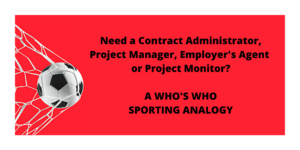Blog Post: Do you know the difference between a Contract Administrator, Project Manager, Employer’s Agent, and a Project Monitor? Part 1 ‘The Contract Administrator’

Misunderstanding the scope of the different roles, often leads to disagreements and disappointment if not suitably communicated and agreed beforehand. Can the sporting world help in unpicking who is who?
The Contract Administration (CA) ‘The Referee’
As contract administrators (CA) we manage the building contract between the ‘two teams’, the client (referred to as the employer) and the builder (the contractor). There are several different types of standard contract available and depending upon the nature, scale, and scope of the works we will often be asked to advise on the options, but in essence the role remains the same.
The client pays our fee as CA and for this reason often perceives that we should be acting in their best interests. To a certain extent they are right as we should not be giving instructions without their express consent. However, the role is an independent one, ‘the referee’, and requires us to act impartially, in the interests of fairness and the spirit of the contract.
We manage the information flow between the client and builder, keeping good records, making site inspections, attending meetings, reporting, and issuing instructions on behalf of our client, monitoring the agreed programme, agreeing, and certifying the value of completed works and deciding when completion is achieved.
As a CA we will follow the rules of the contract and where applicable we will look to the other appointed professionals such as the Architect and structural engineer for suitable support in compliance with the design. For smaller domestic projects these supporting roles will often be called into action as required, the ‘assistant referees’.
The CA role starts when the building contract is signed, or when the whistle is blown. We are not responsible for getting the parties to this point but will ensure that both sides understand their respective obligations. In practice we are appointed well before the contract is signed and often advise the client on contract amendments, and how insurance provisions, consents, licenses, and statutory obligations etc., should be dealt with in the contract – the specific rules changes.
When there is an incident and both parties fall out the CA can feel a bit lonely, with both the client and contractor being able to challenge the CA’s decisions, often placing them under undue pressure to agree with them. Where there is a disagreement either party can take the other to dispute resolution, a kind of video assistant referee ‘VAR’, where the issue can be resolved speedily and without too much additional expense.
Photograph – Contract Administration role followed the specification of the external repairs and redecoration of this stunning mansion block in Maida Vale, completed 2021.

Employers Agent (EA) ‘The Coach’
We use our experience, competence, and technical expertise to support our client’s objectives and goals, in the capacity of a ‘coach’, providing guidance and knowledge.
Our role as the employer’s agent (EA) differs from the role of the CA in that we act on behalf of our clients on all matters. This EA role is exclusive and is usually associated with the specific form of contract known as ‘design and build’. Design and build is used where the building contractor takes on the risk and responsibility for the complete design and construction of a development.
The EA role is often complemented by the client having their own ‘project sponsor’ the ‘team owner’ an as the EA we act on their behalf in coaching the design and construction teams to success.
Our EA role usually begins at tender stage with a concept design ready to go to or having received planning consent. This role starts much earlier than the CA and we will advise clients from the inception of the project, including helping select the rest of the design team, contractors and drafting the project plan or ‘playbook’. The role requires an immense amount of trust.
The EA role is named in design and build contracts in place of the CA but as before must act impartially. We will help pull together our client’s wants and needs, referred to as the ‘Employer’s Requirements’ (ERs). These can be simple or very detailed and specific or performance based, such thermal efficiency targets. The contractor will respond to the ERs and it is responsibility as EA to make sure there are no discrepancies or caveats before the contract is signed.
Photograph – Employer’s agent for a major residential project in Newhaven, East Sussex, due for completion Summer 2023.

The Project Manager (PM) ‘Technical Director’
We are now leaving pitch side to sit in the director’s box. Our role as a project manager (PM) is to lead, direct, manage and be accountable for the success of the project. We are often appointed as a PM when the client is not sure how to take their idea forward and get the building they want and need.
We spend time with our clients, whether individuals or a board of directors who need us to be their strategic advisors and deliver a building that will support, enhance, and even transform their lives or business. We can be involved in funding, communication with external stakeholders, press and media, legal teams and often involved in landlord and tenant matters.
As a PM we are expected to manage risk, consider options for building (traditional or modular), make key decisions (appointing the design team), value engineering (cost saving), scheduling and programming and ensuring the technical aspects of the construction process are tracked. We are the link between the client and the construction and design teams, just as a ’technical’ or ‘sporting director’ might liaise between the team owner and the playing staff.
There are many types and methods of project management including PRINCE2®, Agile, Scrum and Kanban etc. Clients have their own preferences, and we are well versed in the principles of them all.
As PM our authority extends across the design and construction teams, and we can in some circumstances be named in the contract. We will manage the team to develop and deliver a project for the client, providing information, controls and manage communications from the team to the owner so that they in turn can make informed decisions.
The administration of a contract by a PM is associated with the New Engineering Council (NEC) suite of contracts, but as with the CA and EA roles, when named in the contract we must act impartially.
Photograph – Project management role for the new build fishing quay on Eastbourne harbour, phase 1 completed 2021, phase 2 due for completion 2022.

Project Monitoring ‘The Scout’
The role of a project monitor is used where our clients need us to protect their interests in a development for which they have no direct control over. Our clients may be a part funder, the eventual purchaser, leaseholder or even a bank (hence the term bank monitoring).
This monitoring role is outside of the project team and has no real authority. The role is tailored, with the extent and timing of reporting being agreed beforehand. We will usually attend site meetings and report back to our client, who may or may not act upon our feedback and advice. Just as a scout for a sports team acts, identifying and reporting back on possible new talent, but will usually play no part in the negotiations or purchase.
Used extensively for large scale projects when a retail or commercial occupier will want a building built to a certain standard, by a certain time and to a certain quality for their own specific needs but will not fully sign for the purchase or lease until construction is completed satisfactorily.
When acting on behalf of a funder the role can extend to reviewing and reporting back on cost estimates and cash flows and once work is underway, valuations and adjusted final account sums.
As a monitor we must be proactive and try and identify risks and issues before they arise, otherwise there may be a substantial cost to any changes or delays whist agreement is reached. In this regard we must take time to understand our client’s requirements and be in the best position to act on their behalf.
Photograph – Project monitoring role for a new build food, pharma and cosmetics factory in Lewes, East Sussex, completed 2019.

I hope this short blog clears up some common misconceptions on these different roles and feel free to call for impartial advice on how we can assist and support you. Whether you are planning to spend a few hundred thousand or multi millions on your project, your call to us could set you in the right direction for success.
richard@gradientconsultants.com | Tel. 07734 478 775